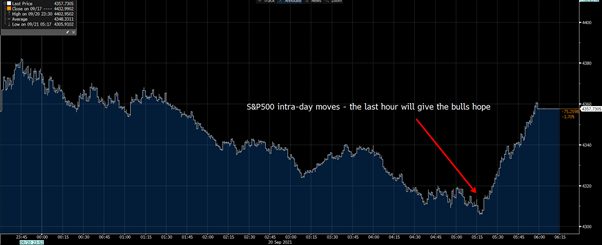Analysis
Worries about Evergrande cause a big deleveraging

While this is not a new theme and has been evolving, it feels like the market was waiting on something from the Chinese authorities over the weekend to calm the markets and ring-fence the contagion worries from a looming Evergrande default and that didn’t come. So what we’re seeing feels like equity portfolio deleveraging and de-risking on the increased pricing and hedging of a policy mistake, with a clear focus on Evergrande’s ability to make a coupon payment on a $2.02b 8% 2022 bond on Thursday.
Traders sense a credit event is coming – I guess this seems reasonable when authorities recently told banks not to expect interest payments on the debt - and this is sending ripples through the broad property sector, which accounts for about 30% of China’s GDP – but the thought for the optimists is that a default will be contained and we know that many of the Evergrande’s corporate debt has been moved dramatically of late and has been marked down accordingly to pay 25 to 30c on the dollar – so it’s not like a default would shock.
The question asked is whether Evergrande decide to fully liquidate or restructure? This could have an effect on contagion risk and push markets into a new volatility regime.
However, while Evergrande is not a new story in isolation, we’ve reached the point where the rubber meets the road and there needs to be an adjustment in markets through this process – aside from watching equity, the macro watchers are watching aspects such as banks Credit Default Swaps (CDS) for true contagion effects into the broader Asian banking channels. At this point it's too early to say we’re in a sustained higher volatility regime.
China’s growth profile is a big red flag
Taking a step back, the moves in China’s property space will almost certainly negatively impact China’s growth at a time when they’ve taken actions taken to limit the purchases of certain raw materials. A slower pace of growth in China raises this word ‘stagflation’ again and in the face of Fed tapering and potentially signalling a faster pace of hikes this is reason in itself to de-risk. Powell should downplay the ‘dots’ in his press conference this week, but this mix is a fairly toxic combo for markets, especially when we consider elevated valuation and then throw in a holiday period in China and HK (Wednesday).
One could easily see options and flow playing a key role in the volatility too, and if the street held a short volatility and gamma exposure, then they’d be covering that – the VIX index has therefore been a focal point pushing to 28.79%, before falling to 25.7% into the S&P500 cash close. The options flow is perhaps why various indices have seen greater percentage moves than we have been used to, even if the S&P 500 had a solid 1.20% rally in the last hour of trade. Obviously, all eyes on the HK50 and CN50 today, and the property-related names – if holding a commodity play or AUD, then the tape in HK could be the guiding light over the coming 24-48 hours.

(Source: Bloomberg - Past performance is not indicative of future performance)
FX markets have been relatively quiet with AUDUSD rallying 30-pips off the lows of 0.7220 and incredibly it’s not high beta FX that’s underperformed, but the GBP which has fared the worst down 0.6%. I guess the world has amassed a sizeable AUD short position already, in fact, the weekly CoT report shows speculators holding a record AUD short position.
Bonds have caught a bid, but the US 10yr Treasury is -5bp, but that’s not huge by any means and in a true vol shock it would be closer to 10bp. US high yield credit has widened but again it's quite measured and no panic.
Commodities are a must watch given the perception of a slowdown in China – but how much is now priced? Copper is -2.8% and crude and gasoline are down 1.8% and 2.2% respectively but we’re seeing iron ore futures on the SGX rally 2.9% in the US session.
Related articles
The material provided here has not been prepared in accordance with legal requirements designed to promote the independence of investment research and as such is considered to be a marketing communication. Whilst it is not subject to any prohibition on dealing ahead of the dissemination of investment research we will not seek to take any advantage before providing it to our clients.
Pepperstone doesn’t represent that the material provided here is accurate, current or complete, and therefore shouldn’t be relied upon as such. The information, whether from a third party or not, isn’t to be considered as a recommendation; or an offer to buy or sell; or the solicitation of an offer to buy or sell any security, financial product or instrument; or to participate in any particular trading strategy. It does not take into account readers’ financial situation or investment objectives. We advise any readers of this content to seek their own advice. Without the approval of Pepperstone, reproduction or redistribution of this information isn’t permitted.

